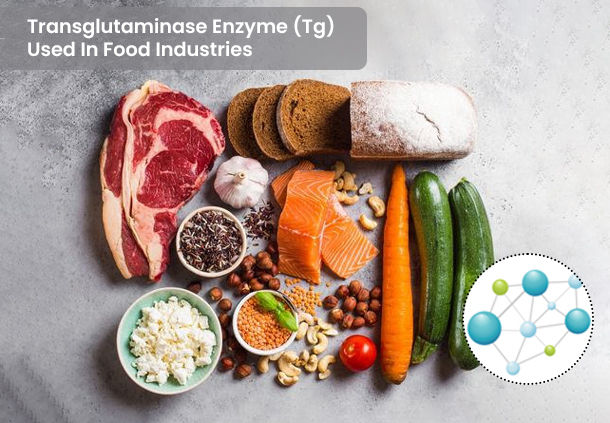
Before knowing all about Transglutaminase (TG) Enzyme, it’s better to start with the fact of it to comprehend its existence. Some principal components of our food production and supply frequently come under and leave public attention due to dietary trends’ ups and downs, meanwhile, there is some unsettling information about novel food ingredients and rediscoveries of foods around.
Transglutaminase Enzyme comes under such food ingredients, a naturally developed enzyme that works as a component to build up the taste and improve food consistency in bakery and meat products. Before getting to the roots, let’s begin with the understanding of what is Transglutaminase Enzyme.
What is Transglutaminase Enzyme?
Transglutaminase, usually referred to as TG in simplified notation, is a common enzyme that can be found in people, animals, plants, and microorganisms. Our bodies use transglutaminase tg to aid with nutrition, digestion, muscle growth, and the removal of pollutants. This enzyme is extensively spread throughout the globe and is collected through molecules of basic amino acids.
How Does Transglutaminase Enzyme Function?
In liquid proteins, transglutaminase function stimulates the cross-linking of the side molecules of two amino acids, glutamine and lysine. In the process of creating protein bonding, transglutaminase TG unites the different types of meat. This results in the establishment of iso-peptide bonding amongst proteins and the releasing of the -(glutamyl)-lysine chain. Physical strain and heat processing doesn’t break this connection. Transglutaminase functions as a catalyst to aid in the unaltered binding of dietary proteins. It is employed to increase food items’ stickiness, stiffness, flexibility, and ability to bind fluid. As a result, the food products’ aroma and consistency are strengthened. The industrial manufacture of numerous food products makes use of Transglutaminase’s bridge ability. Among these are the production of baked items, cheese, and other milk products.
What Are Transglutaminase Enzyme’s Uses?
Enzymes are employed in foodstuff to create flavours, colours, and textures as well as to improve our favourite meals’ edibility. Producing cheese, fermenting beer, kneading bread, and extracting fruit juice all contain enzymatic functions.
The transglutaminase enzyme stimulates the acylation process between primary amines, such as protein lysine residues, and different glutamine residues that are linked to peptides. Also, transglutaminase TG creates linkages in proteins, altering their structural makeup and enhancing their operational characteristics. That included fluidity, consistency, and the ability to retain liquid without degrading the nutrient benefit of lysine.
Moreover, other functions of transglutaminase comprise as below:
- Uniformizing the size of the meat, chicken, and seafood for safe and consistent cooking.
- Increasing the taste, smoothness, and presentation of meals while minimizing food waste. As a result, there are significant financial benefits and fewer negative ecological effects.
- Transglutaminase uses work well at reducing systemic toxicity in acid milk gels, which enhances milky yoghurt texture and its longevity. Additionally, it enhances the texture of ice cream by being utilised in its manufacture.
- combining sausages, chicken, and seafood
- Generating inventive food mashups (like beef and bacon); & Using foodstuff to create unique impacts
- To provide more upscale culinary and exquisite meal encounters, such as spaghetti with shrimp and other meat noodles manufactured from a combination of plant and animal protein ingredients.
Is Transglutaminase (TG) Enzymes Safe?
Absolutely. The U.S. Food and Drug Administration (FDA) has categorised TG as GRAS (generally recognised as safe) for more than a decade, meaning it is considered safe.
In order to meet the demands of our expanding civilization, TG has so far shown to be a secure way to combine food items. Despite popular belief, Transglutaminase in food does not worsen or encourage contamination of meat, and it has no effect on how allergic molecules are. Most importantly, when food is cooked all the way through, then the enzyme is destroyed.
How Do You Get Transglutaminase (Tg)?
Since transglutaminase TG is a frequently occurring enzyme, it can be obtained in both animal and plant foods. This enzyme, which is deemed meat-free and vegan, is isolated economically from the fermentation bacterium Streptoverticillium mobaraense.
Conclusion:
The usage of TG is secure when done correctly. The study of transglutaminase’s impacts on celiac disease is still being conducted. Since TG was first added to our food production more than 20 years ago, there haven’t been any recognised problems with food security, or scientifically determining population health. So, if Transglutaminase in food is still causing you anxiety, reviewing the ingredient declaration will make it clear what it is. Meanwhile, we should have the knowledge and capacity as consumers to make intelligent food decisions.
Through enhanced technology and modern labs, Ultrez Enzymes with its team of experts makes sure to offer quality products. The in-house products go through precise quality check procedures to attain the best industry standards.
Looking for a pioneer in enzyme manufacturing and distributing? Connect with us.


